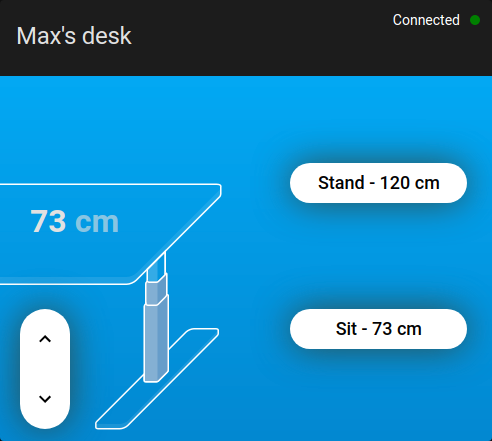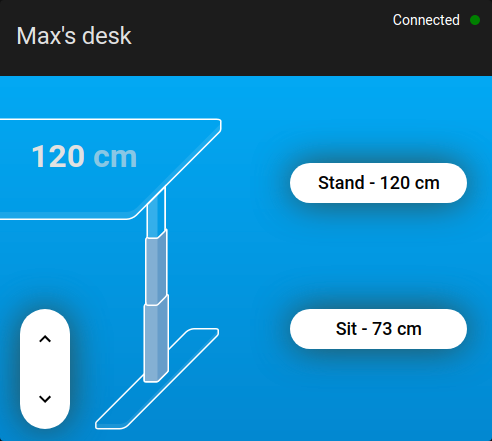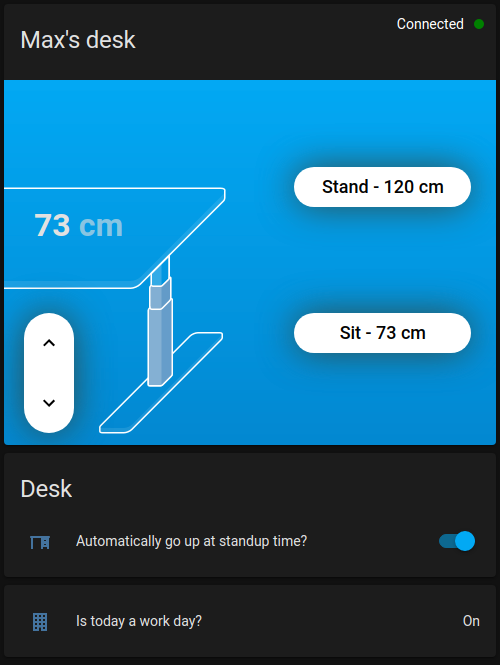- Linak to MQTT dockerized service
- Use your bluetooth dongle without the need of an ESP32 device to control your desk
- Can be integrated with Home Assistant and https://github.com/IhorSyerkov/linak-desk-card
Credits: This project wouldn't have been possible without the incredible work done by @rhyst on the idasen-controller project ❤️. Don't forget to give him a ⭐!
Your host must have your desk paired and trusted as a bluetooth device first.
The reason for that being: When starting out the docker we give access to the bluetooth dongle and all the config. This way the docker image is able to connect to the desk straight away.
From the host:
bluetoothctl[bluetooth]# power off[bluetooth]# power on- Press the button on the desk for 2 or 3s till the LED is blinking
[bluetooth]# scan on
Example of output while the scan is on
Discovery started
[CHG] Controller XX:XX:XX:XX:XX:XX Discovering: yes
[CHG] Device XX:XX:XX:XX:XX:XX RSSI: -83
[CHG] Device XX:XX:XX:XX:XX:XX RSSI: -71
[NEW] Device XX:XX:XX:XX:XX:XX Desk 7734 <-- notice the [NEW] here
[CHG] Device XX:XX:XX:XX:XX:XX RSSI: -75
[CHG] Device XX:XX:XX:XX:XX:XX RSSI: -95
[bluetooth]# scan off[bluetooth]# trust XX:XX:XX:XX:XX:XX[bluetooth]# pair XX:XX:XX:XX:XX:XX
And from here you should see the prompt like this [Desk 7734]# meaning you're connected to the desk, at which point you must disconnect from it by typing [Desk 7734]# disconnect
All the configuration on the side of the host is now done and you should not have to manipulate anything here anymore.
The docker image will connect to your desk and interact with it through MQTT so that you can interact with it the way you want.
Before building and launching it:
- Copy
linak-2-mqtt.env.templateinto a new file calledlinak-2-mqtt.envand update the values - Copy
linak-config.yaml.templateinto a new file calledlinak-config.yamland update the values (at least the mac address)
Then:
docker build -t linak-2-mqtt .docker run -it --rm --privileged -v /var/run/dbus:/var/run/dbus -v $(pwd)/linak-2-mqtt.env:/.env -v $(pwd)/linak-config.yaml:/linak-config.yaml linak-2-mqtt
You can listen to:
linak-2-mqtt/desk-height-updatedwhich will pass the desk height as payload in cm
You publish to:
linak-2-mqtt/set-desk-heightpass the desk height you wish in cmlinak-2-mqtt/toggle-desk-positionno payload needed
The MQTT API ensure you can build any kind of integration you'd like. Speaking for myself, I've chosen to use Home Assistant. In this seection I'll explain how to specifically integrate your desk in Home Assistant and give some examples of automations.
@IhorSyerkov has built a great (interactive) Lovelace card:
| Desk in sitting position | Desk in standing position |
|---|---|
 |
 |
This was originally built to integrate with ESPHome idasen-desk-controller (see linak-desk-card's documentation), but I didn't want to have using another device hence why I built my own solution.
That's why we've got a little bit of configuration to make on Home Assistant in order to have the card working properly.
- Start by following linak-desk-card's README and install the card using HACS
- Open your HA config file
/config/configuration.yamland either create or update yoursensorandbinary_sensorlists with the following:
mqtt:
sensor:
- name: linak_desk_height
state_topic: 'linak-2-mqtt/desk-relative-height-updated'
- name: linak_desk_absolute_height
state_topic: 'linak-2-mqtt/desk-absolute-height-updated'
- name: desk_need_update
state_topic: 'linak-2-mqtt/need-update'
- name: desk_sitting_status
state_topic: 'linak-2-mqtt/sitting-status'
binary_sensor:
- name: is_desk_available
state_topic: 'linak-2-mqtt/desk-relative-height-updated'
off_delay: 100
value_template: "{{ 'online' }}"
payload_on: 'online'
payload_off: 'offline'On your dashboard, we'll now create a new card:
type: custom:linak-desk-card
min_height: 62
max_height: 127
presets:
- label: Stand
target: 120
- label: Sit
target: 73
name: Desk
height_sensor: sensor.linak_desk_height
connection_sensor: binary_sensor.is_desk_available
# @todo not implemented because I'm unsure what that'll change and it's not a priority for now
# moving_sensor: binary_sensor.is_desk_moving
desk: cover.deskImportant note:
Make sure the config above matches:
- The one defined in
linak-2-mqtt.envthat you're mounting on the docker container for:min_height/DESK_LOWEST_HEIGHT_CMmax_height/DESK_HIGHEST_HEIGHT_CM
- The one defined in
linak-config.yamlthat you're mounting on the docker container: presets[label="Stand"].target/stand_heightpresets[label="Sit"].target/sit_height
This is slightly annoying to have some configuration duplicated but I haven't found a better option for now and it's not something you'll need to edit all the time.
Everything we did so far was in order to get the correct height displayed on the desk card. Now lets hook the 2 buttons stand and sit so we're able to control the desk from that card as well.
In order to do that, you'll need to create the following automation:
alias: 'Desk: Bind cover.set_cover_position to MQTT'
description: ''
trigger:
- platform: event
event_type: call_service
event_data:
domain: cover
service: set_cover_position
condition: []
action:
- service: mqtt.publish
data:
topic: linak-2-mqtt/set-desk-height
payload_template: >
{% set service_data =
trigger.event.as_dict().get('data').get('service_data') %} {{
((service_data.get('position') * (127 - 62) / 100) + 62) | round(0) }}
mode: singleNote: Same here, it'd be nice to get the 127 (max height) and 62 (min height) from the card config if possible but I haven't done it for now.
alias: 'Tag Desk: Toggle desk position'
description: ''
trigger:
- platform: tag
tag_id: YOUR-TAG-ID-HERE
condition: []
action:
- service: mqtt.publish
data:
topic: linak-2-mqtt/toggle-desk-position
mode: singleLast but not least, if you have some daily standup meeting for example, you could automatically put the desk up at that time if:
- It's a work day
- You're home
- A manual input boolean is currently on (in case you ever want to turn it off simply)
All this should let you avoid unnecessary triggers.
alias: 'Desk: Standing position at standup time on workday if I am home'
description: ''
trigger:
- platform: time
at: '10:59:00'
condition:
- condition: zone
entity_id: device_tracker.PHONE_TRACKER_HERE
zone: zone.home
- condition: state
entity_id: binary_sensor.workday_sensor
state: 'on'
- condition: state
entity_id: input_boolean.shoulddeskgostandingpositiononworkdaysifiamhome
state: 'on'
action:
- service: mqtt.publish
data:
topic: linak-2-mqtt/set-desk-height
payload: '120'
mode: singleDon't forget to create both:
- the
input_booleanhelper - the
workday_sensorif you don't have one already. Example:
binary_sensor:
# ... your other binary sensors
- platform: workday
name: workday_sensor
country: FR
workdays: [mon, tue, wed, thu, fri]
excludes: [sat, sun]Here's an example of complete dashboard:
- theme: Backend-selected
title: Office
path: office
badges: []
cards:
- type: custom:linak-desk-card
min_height: 62
max_height: 127
presets:
- label: Stand
target: 120
- label: Sit
target: 73
name: Desk
height_sensor: sensor.linak_desk_height
connection_sensor: binary_sensor.is_desk_available
moving_sensor: binary_sensor.linak_desk_moving
desk: cover.desk
- type: entities
entities:
- entity: input_boolean.shoulddeskgostandingpositiononworkdaysifiamhome
name: Automatically go up at standup time?
title: Desk
show_header_toggle: false
state_color: false
- type: entities
entities:
- entity: binary_sensor.workday_sensor
name: Is today a work day?
icon: mdi:office-building
state_color: false
# Troubleshooting issues
If the logs show
[debug] Connected starting idasen server... Connecting Connecting failed Device with address XX:XX:XX:XX:XX:XX was not found.
Either:
- You've never connected the desk in bluetooth. Refer to `Bluetooth initial setup`
- Another device is already connected to the desk. Check first on your host machine if `bluetoothctl` shows `[bluetooth]#` or something like `[Desk 7734]#`. If it's `[bluetooth]` it means it's fine, the host is not connected to it (but you'll have to check your other devices like phone etc...), if it shows `[Desk 7734]#` the fix is easy, from here type `disconnect`: `[Desk 7734]# disconnect` and it should go back to `[bluetooth]#`. Stop and start again the docker image, everything should be fine
- Something has just gone wrong and none of the above fixes it. Try first on the host to
- Turn the bluetooth on and off
- `bluetoothctl`
- `[bluetooth]# power off`
- `[bluetooth]# power on`
- Connect to the device again `[bluetooth]# connect XX:XX:XX:XX:XX:XX`
- If that works, disconnect from it straight away (`[Desk 7734]# disconnect`) and relaunch the docker image
- If that doesn't work, you may need to remove the device and make sure that you: Find it, trust it, pair it (in this order)
- `[bluetooth]# remove XX:XX:XX:XX:XX:XX`
- From here follow again the `Bluetooth initial setup` section
# Useful links
- https://github.com/rhyst/idasen-controller/issues/42#issuecomment-1059736659
# Linak DPG1C integration and keep alive routine
In order to use it with the Linak DPG1C there are some caveats. A new MQTT topics has been added:
- linak-2-mqtt/need-update
As the DPG1C *needs* a wake up command that, at the time of writing, has not been implemented on the idasen server, an automation has to be done. It seems that a wake up command needs to be sended once every three hours in order to keep the connection alive. So, to do that, some logic has been added:
- if the mqttSetHeightCommand is been triggered, the time is stored in last_updated variable
- then periodicaly the difference between last_updated and now is calculated. If that time is greater than 1h the topic linak-2-mqtt/need-update is set to 1.
In HA (for example) we need to create an automation to move the desk from the bluetooth controller to keep the connection alive when the need-update topic is 1:
alias: Keep Desk alive description: "" trigger:
- platform: mqtt topic: linak-2-mqtt/need-update payload: "1" condition: [] action:
- service: mqtt.publish data: qos: 0 retain: false topic: linak-2-mqtt/set-desk-height payload_template: "{{(int(states('sensor.linak_desk_absolute_height')))-1}}"
- delay: hours: 0 minutes: 0 seconds: 5 milliseconds: 0
- service: mqtt.publish data: qos: 0 retain: false topic: linak-2-mqtt/set-desk-height payload_template: "{{(int(states('sensor.linak_desk_absolute_height')))+1}}" mode: single
# Keep track of Sitting vs Standing status
A routine has been implemented to publish to linak-2-mqtt/sitting-status if the desk is standing or sitting position.
if(heightCm > linakConfigYamlParsed.stand_height/10 - tolerance){
sitting_status = "Standing"
}else if (heightCm < linakConfigYamlParsed.sit_height/10 + tolerance){
sitting_status = "Sitting"
}
client.publish(
linak-2-mqtt/sitting-status,
sitting_status
);
Tolerance variable is set to 5cm. #TODO: Move it to .env file?
Then in HA configuration.yaml we can create some sensors:
sensor:
- platform: history_stats name: Desk sitting time entity_id: sensor.desk_sitting_status state: "Sitting" type: time start: "{{ now().replace(hour=7, minute=30, second=0) }}" end: "{{ now().replace(hour=17, minute=0, second=0) }}"
- platform: history_stats name: Desk standing time entity_id: sensor.desk_sitting_status state: "Standing" type: time start: "{{ now().replace(hour=7, minute=30, second=0) }}" end: "{{ now().replace(hour=17, minute=0, second=0) }}"
- platform: history_stats name: Desk standing ratio entity_id: sensor.desk_sitting_status state: "Standing" type: ratio start: "{{ now().replace(hour=7, minute=30, second=0) }}" end: "{{ now().replace(hour=17, minute=0, second=0) }}"
- platform: history_stats name: Desk sitting ratio entity_id: sensor.desk_sitting_status state: "Sitting" type: ratio start: "{{ now().replace(hour=7, minute=30, second=0) }}" end: "{{ now().replace(hour=17, minute=0, second=0) }}"
Note that this only keeps track of the sitting vs standing times and ratio from 7:30 to 5 which are mine working hours. Please change it to yours :)
